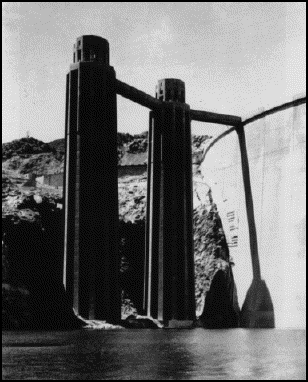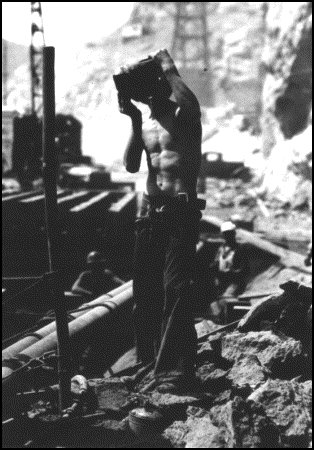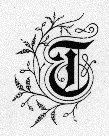Dam
The Photographs
Of Ben Glaha
Barbara Vilander
(University of Arizona)
 It took a hundred years of studies, and over a million cubic feet of cement. It was begun in 1931, and finished in 1936. Even though it was funded before the New Deal, it was a perfect symbol of Roosevelt's the new style --- so he stole it from the President for whom it would ultimately be named.
It took a hundred years of studies, and over a million cubic feet of cement. It was begun in 1931, and finished in 1936. Even though it was funded before the New Deal, it was a perfect symbol of Roosevelt's the new style --- so he stole it from the President for whom it would ultimately be named. It was colossal in every way, employing thousands, for the benefit of the people of Utah, Wyoming, New Mexico, Arizona, California, Nevada, and Colorado. It stabilized the highly erratic flow of the Colorado River, made formerly arid farmland suitable for crops, and provided water and electricity to the seven states.
Needless to say, it destroyed an entire ecosystem --- but we were innocent in those days, insensitive to the fact that "taming" meant destroying. It made the owners of the six companies which formed a consortium to build it very wealthy, and set up patterns of water distribution that, to this day, are skewed in favor of huge agribusinesses of the west. It also gave us the dubious bonus of the present day electricity-piggie house known as Las Vegas.
The Bureau of Reclamation wanted to make damn sure that there was a photographic record, primarily for propaganda purposes, because for such an expenditure of money, they wanted full public support. It fell to Ben Glaha to be the project photographer. Glaha was certainly no hack: he was friend to Ansel Adams and Margaret Bourke-White, and Dr. Vilander tells us, he was fond of "fine food, music, and art."
 His job was to comfort the public (rumors were that the dam was built atop a fault line), and his photographs were to emphasize "productivity, safety, and thrift." At the same time, he managed to interject a note of aesthetics in what would otherwise be nothing more than governmental run-of-the-mill shots. His photography was what they call "machine aesthetic" --- in which essentially unbeautiful objects --- cement, wires, towers, trucks, sweaty workmen --- are made stark, breath-taking.
His job was to comfort the public (rumors were that the dam was built atop a fault line), and his photographs were to emphasize "productivity, safety, and thrift." At the same time, he managed to interject a note of aesthetics in what would otherwise be nothing more than governmental run-of-the-mill shots. His photography was what they call "machine aesthetic" --- in which essentially unbeautiful objects --- cement, wires, towers, trucks, sweaty workmen --- are made stark, breath-taking.
Dr. Vilander's choice of photographs (over fifty by Glaha alone) and her exhaustive text are all workmanlike, but the writing can be a bit overwrought. An album prepared for Interior Secretary Harold Ickes opened with a shot of "Workman with Water Bag" [Fig. 2 above] which image, she tells us,
functions as something of an icon for the entire project. The singular man, captured with no tools in his hand, symbolizes the many individuals who tamed the Colorado River with brawn and intellect. The water bag alludes to the river, to the very focus of the man's efforts. Bringing drinking water to a single person, which in turn fuels him to complete the monumental task at hand, refers to the Bureau's effort to direct water for drinking and irrigation to millions of people.
Still, its a fine collection out of another, simpler era, one in which government and capital could march hand-in-hand to "tame the river," (the river, the wilderness seen as the enemy, to be civilized). In the process, we find hundreds of fascinating facts popping up here and there, such as
divers checking the silt level at the upstream face of the dam supposedly encountered fish described as carp the size of Volkswagen Beetles, and the reason the water in Lake Mead is blue and the water exiting the dam from the powerhouse downstream is green is said to be that the interior of the intake towers was coated with yellow paint.

Bruise
Terry Wolverton
(Red Hen Press)
Sex, anyone? Nope, for
Gyrations of love leave us emptied, parched
its myth too feeble to succor our days.
Sex grinds on, monotonous as a clock,
stained with betrayal, cruel and bloody;
flesh rasps against flesh, dry as a rattle,
the tendons of lust now puny and thin.
The Buddhists tell us that all of life is a pain, yet Keats was able to find joy in a bird, or a piece of pottery, Fitzgerald in noble, misguided romanticism, Shakespeare in the wonder that we can see into the black heart and still find hope --- that despite life being such a mess (duty, passion, age, loss, and blood-lust), we just keep at it. We all have problems, but Ms. Wolverton gets the Moon (or Moan) of Misery locked in the lens of her little telescope, and refuses to turn it a bit to see (for instance) the glorious rings of Saturn. Even at those moments of joy, "Sex at Menses," where
Defiantly we'd streak our thighs
with crimson, fingers dipped and dripping
while the scarlet Rorschach spread along the sheet...
it turns to a "deadly spectre" where
Our passion, when it sparks at all, glimmers behind sheets
of latex, its taste industrial and flat.
One of my old therapists said that self-pity was the most dangerous disease to rot the soul of America. Mystery Bruise is an extended paean to that black plague.
Done That
Eddie Fisher,
with David Fisher
(Thomas Dunne Books)

How did he do it? It came naturally. "My technique was that I opened my mouth and let it out. I was born in tune. I didn't know flats or sharps, and I couldn't read music. I just opened my mouth and sang."
When he went to Korea, President Truman said that he was his "favorite PFC." When he returned, he married Debbie Reynolds, the girl next door. Their's was the ideal marriage, at least to the media. "I've often been asked what I learned from that marriage," he says. "That's simple: Don't marry Debbie Reynolds."
Soon enough, he left Debbie for Elizabeth Taylor. When that marriage collapsed, he got hitched to Connie Stevens. Throughout all these musical chairs, he was singing, pouring out records --- and the money was pouring in.
He knew all the stars of American 50s entertainment --- Mike Todd, Frank Sinatra, Dean Martin, Eddie Cantor, Bing Crosby, Elvis Presley, Anthony Quinn, Donald O'Connor. And women? Queen Elizabeth asked him to dance; Bette Davis "made drool eyes at me." He knew, sometimes intimately, Ava Gardner, Audrey Hepburn, Marilyn Monroe, Gina Lollobrigida, Brigette Bardot, Joan Collins, Sue Lyon, Lana Turner, Margaret Truman. So much fun, so many parties, and the women! One wonders how he was able to find time to record songs between his bouts of passion.
In anyone else's hands, this would be your typical ho-hum let-me-tell-
Especially when he is telling us exactly what it was like to live with Elizabeth Taylor. For instance, She was drinking and taking pills and passing out. She was constantly passing out. It was just awful; not awful enough to make me miss my life with Debbie, but awful.
Once when he threatened to leave, she swallowed an entire bottle of Seconol. I tried to stay calm, although it's hard to stay calm when foam is coming out of your wife's mouth. Another time, he dared to venture the opinion that she should do something about her addictions. He said to her, "Elizabeth, what would you think about going to see a psychiatrist?" As it turned out, not very much. She erupted. She started screaming at me...She got out of bed, totally naked, and ran down the stairs. I ran right after her. She got into her Cadillac and turned on the engine. It was crazy, this hysterical naked woman trying to drive while I ran alongside the car, holding on to her door. I was begging her to stop, telling her, "It's not you, it's me. I'll go to the psychiatrist. I'll go, I'll go, it's me..."
She was smart and funny and beautiful. And sexy. Very, very sexy. Sexually she was every man's dream; she had the face of an angel and the morals of a truck driver. The tale of Elizabeth and Eddie --- they called him "Mr. Taylor" --- is enough to make a grown man cry...and, often, to laugh: "The one thing that it was impossible to ever forget when you were with Elizabeth Taylor," he tells us, "was that you were with Elizabeth Taylor."
Fisher did not marry Elizabeth Taylor. Rather, he entered into a contract with her to let her run his life, and to be subject to her every whim, to deal with her incessant pill-taking, her endless booozing, her tantrums, her sulks, and her impossible Jezebel nature.
"I had successfully made the transition from one of the country's most popular singers to Elizabeth's companion and nurse, [he explains]. I was caught in a magnificent trap, and even though I was madly in love with her, it was still a trap. I'd forgotten who I was...The only singing I was doing was around the house. And what did he do when he she ran off with Richard Burton? I couldn't stop loving her, and needing her. I missed her more than I had ever missed anyone in my life. I couldn't sleep. I couldn't eat. I couldn't sit still, so I did the only thing that made sense at the time. I appeared on the television quiz show What's My Line as the mystery guest. His final meeting with her gives him a chance to reflect on what he had been to her --- and what Burton was now to become for her: We met at their suite at the Regency. I was surprised at how the balance of their relationship had changed. Elizabeth was in complete control, Burton had become almost docile and very domesticated...As Elizabeth and I were talking, he was performing all my old duties: He was picking up, giving her a pillow, pouring drinks. He had become her nurse. Maybe he was doing Hamlet onstage, but in real life he was playing my role.
I had arrived at Max Jacobson's office for my shot and found the place in an uproar. Come wit me, he ordered. I haf to see the President. I knew Max had very powerful friends, but the President?...With Max, anything was possible. Max could make night into day. Max with his filthy fingernails and his magic potions treating the President of the United States? In those days, people knew nothing about the addictive power of meth. It was the prescribed drug of choice for weight reduction and pain (JFK took it for his back). If the doctor gave you an injection, and if it worked --- you didn't ask what it was. No one questioned Max with "the dirty fingernails" and the bottles with no labels which he mixed and matched, apparently at random.
For some of us, it puts a whole new cast on Camelot and the White House. Does this explain how JFK was able to stay awake and alert for the entire Cuban Missile Crises? Was he gooned out when he hired all those noodle-headed advisors like Dean Rusk and Robert McNamara? Is this what got us enmeshed in Viet-Nam?
According to Fisher, The President took Dr. Max with him when he went to Vienna for a summit meeting with Russian Premier Nikita Khrushchev. Looking back on it, it's amazing how we all just accepted the fact that the President was taking Dr. Feelgood with him to a meeting that would affect the entire world. The fate of the free world rested on Max's injections. I can still see Max taking a little from this bottle, a little from that one, and pull down your pants, Mr. President. By the time I was thirty-three years old I'd been married to America's sweetheart and America's femme fatale and both marriages had ended in scandal; I'd been one of the most popular singers in America and had given up my career for love; I had fathered two children and adopted two children and rarely saw any of them; I was addicted to methamphetamines and I couldn't sleep at night without a huge dose of Librium. And from all this I had learned one very important lesson: There were no rules for me. I could get away with anything so long as that sound came out of my throat. Who would ever suspect that Eddie Fisher, the man who made so many awful records --- songs he himself calls "bubble-gum" --- the man who was shooting meth and cocaine for thirty-seven straight years, the one who bungled several marriages with several of the most gorgeous women in Hollywood --- who could ever guess that he would create an autobiography that is such a kick in the pants?
This is a man who, literally, got a shirt off of JFK's back; one who loved the loveliest women of our time; one who hung out with all the stars and the mafioso kings; one who was turned down part ownership in Caesars Palace ("I wanted nothing more to do with Caesar and Cleopatria"); the man who abandoned all his children, the man who's third wife would write, I wish you good luck, good health and wealth and happiness in your own time on your terms --- I do not wish you love as you wouldn't know what to do with it. This is the man who shot up with the stars, and who ended up, in his final desperate days, travelling with Roy Radin's Vaudeville Review, also known as "The cavalcade of has-beens." Along with Fisher and Tiny Tim, there was Donald O'Connor, "who was whacked out of his mind most of the time," and Georgie Jessel, who said, "I'd like to retire, but if I did, I'd have to eat my newspaper clippings."
Before, he said, "I walked into theatres and championship fights without a ticket. I could make a phone call and have airplanes wait for me. Now I had to learn how to lead a normal life." He and the other once-popular ex-stars were exhibited in smelly theatres and shopping centers. "As long as I sounded more like Eddie Fisher than the Elvis impersonator sounded like Elvis," he reports, the audiences "were thrilled."
And the second?
He makes it quite clear that even now, at this late stage, his main regret is that he wasn't able to hang onto his Number One shiksa, Elizabeth Taylor.
Readers aren't going to be very impressed by this juvenile passion, and certainly not by his endless roll-call of sexual conquests.
But we are impressed that he is able, at this late date, to come up with a brand new act, one associated neither with his music or his weenie. Here we have a faded pop star who has, out of the blue, developed a brand new trick --- one that he doesn't even mention in Been There, Done That.
That trick: the ability to write winningly and well.
His story is self-deprecating, and droll --- and sometimes very sad. But all the while it's honest, and very very good.
 here's a genuine juvenile enthusiasm in Been There, Done That. It's the sense of wonder that you and I would have if we woke up one morning to find ourselves a star. And we get the feeling that he's still stunned that a poor kid from the streets of Philadelphia could end up , all of a sudden, living "under the bank on the hill, where the money just rolls down." With Elizabeth Taylor.
here's a genuine juvenile enthusiasm in Been There, Done That. It's the sense of wonder that you and I would have if we woke up one morning to find ourselves a star. And we get the feeling that he's still stunned that a poor kid from the streets of Philadelphia could end up , all of a sudden, living "under the bank on the hill, where the money just rolls down." With Elizabeth Taylor.
 isher's first experience with drugs came from one Dr. Max Jacobson. He remembers the date with exactitude: April 17, 1953. And he didn't stop for thirty-seven years. Most of the famous people he knew --- in show-biz, in music, in politics --- were doing it. Even John Fitzgerald Kennedy:
isher's first experience with drugs came from one Dr. Max Jacobson. He remembers the date with exactitude: April 17, 1953. And he didn't stop for thirty-seven years. Most of the famous people he knew --- in show-biz, in music, in politics --- were doing it. Even John Fitzgerald Kennedy:
 hat sets Fisher's tale apart from the thousand-and-one other I-Was-A-Star Books that have been turning up lately is the fact that he is obviously no dummie. He's someone who can tell us his funny-sad tale with wit and a certain amount of astute introspection. At certain points, he will stop and make a cogent summary of the fool things he did with his life :
hat sets Fisher's tale apart from the thousand-and-one other I-Was-A-Star Books that have been turning up lately is the fact that he is obviously no dummie. He's someone who can tell us his funny-sad tale with wit and a certain amount of astute introspection. At certain points, he will stop and make a cogent summary of the fool things he did with his life : isher is now seventy-years-old. Surprisingly, he survived. He, apparently, only has a couple of regrets. One is that he wasn't a better father.
isher is now seventy-years-old. Surprisingly, he survived. He, apparently, only has a couple of regrets. One is that he wasn't a better father.